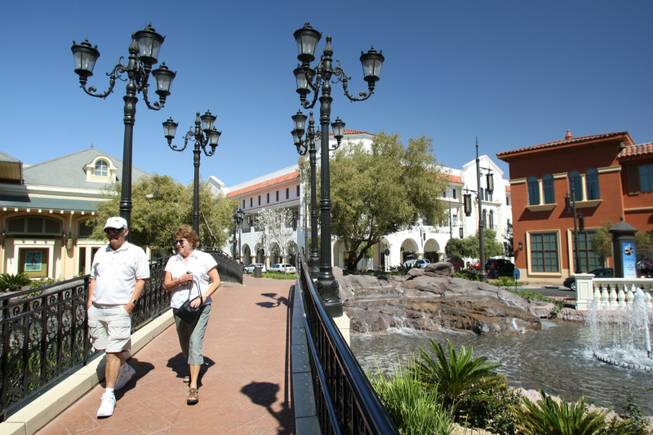
Jim and Sharon Vargo of Lake Delton, Wis., cross a bridge at Town Square on March 20, 2009.
Friday, March 27, 2009 | 2 a.m.
Sun Archives
- Staples expands into Las Vegas (3-6-2009)
- First Costco Business Center in Las Vegas opens (2-20-2009)
- WMC to open Design Salon (2-13-2009)
- Manufacturers scramble to make every possible sale (1-30-2009)
- Encore Esplande shops reveal sense of discovery (1-30-2009)
- Wireless retailers advised to emphasize great customer service (1-23-2009)
Beyond the Sun
The extent to which the Las Vegas retail market has changed for developers and investors was brought into sharp focus at a recent International Council of Shopping Centers event.
The program, titled “We Will Survive,” took place at Maggiano’s Little Italy at the Fashion Show mall on Las Vegas Boulevard and was presented by Next Generation, ICSC’s mentoring program for young retail real estate professionals.
It focused on how young investors, many of whom have never experienced a slump of any kind, can best weather the storm of this potentially devastating economic downturn.
Speakers included Nick Hannon, senior vice president of Territory Inc., Robert Hart, relationship manager for Small Business Administration loans at Nevada State Bank, and Tami Lord, a vice president at Voit Commercial.
From the first question posed by moderator Lindsey Mitchell, a marketing specialist at Territory Inc., it was clear the panel was going to provide answers that reflect the harsh new reality of the retail landscape in Las Vegas.
The silver lining to this economic downturn that has claimed so many casualties, Lord said, is that a sense of normalcy should return to the industry soon.
“The positives are that we are resetting the rents to a sustainable level and we’ve got land prices resetting to where they should have been,” Lord said. “We’ve got a cleansing going on of tenants that maybe needed to wash out in the first place.”
Many of the longtime industry professionals who are used to dealing with business cycles should be able to hang on. Some of the more recent investors that foolishly believed they could ride the wave forever and are unprepared to handle the tough times, Lord said, will fall by the wayside.
Of course, even some veteran lenders and developers were caught off guard by the severity of this particular decline and are also scrambling to stay afloat.
“A lot of the bankers that have been in banking for 30 years have never seen anything like this, so it’s a real challenge for us,” Hart said. “From a positive side, we’re getting requests to purchase buildings now that the per-square-foot prices that we are seeing can be supported very easily with the appraisals.”
A cleansing of the market, Lord says, should also provide an opportunity for new and better retailers to come into the market, and most of the properties should once again be handled by experienced professionals.
“You get back to the days when folks that know how to develop are the ones developing and you don’t have a lot of this unanchored strip box that is poorly tenanted and winds up vacant,” Lord said.
Hannon was even more candid in his assessment, but he also offered some encouragement to the neophytes in the audience.
“In a repressed time there is a culling of the weak that go back to being bartenders and limo drivers,” he said. “They will cull out of the business, and those of you who endure and keep discipline when the lift comes, you’re going to ride it. If you can survive in this kind of market and it lifts, you’ll think you are just shooting ducks on the pond.”
From a lender’s perspective, Hart says the Small Business Administration is doing its part to try to jumpstart the economy.
“In our world, which is the Small Business Administration, everybody has been reading about all of the changes … and they are great,” Hart said.
The SBA, for example, has raised the guarantee, which used to be 75 percent of the loan amount on a non-real estate loan, to 90 percent, which Hart said is a great incentive for a lender.
They’ve also waived the fee for the client. Previously, a one-time fee of 2.15 percent was put into the loan and amortized but that has been set aside, at least for this year.
“Those are real positive things and over the last two weeks the phone has just been ringing off the hook for those types of loans,” Hart said.
Despite early indications that suggest a retail renaissance of sorts could be on the horizon, there is still a lot to recover from.
Lord said there are about 40 big box spaces vacant in the area right now, but not all are a result of the sluggish economy. While some vacancies were clearly caused when the parent companies folded, others are the result of a changing demographic in the Las Vegas Valley.
“Look at the corner of Sahara and Decatur, for example,” Lord said. “That demographic has been changing for quite some time. It was time for a retenanting at that intersection to better serve the folks that live there.”
While a correction of the real estate market and the availability of funding could hasten a recovery, the reality is that retail in the valley may never again reach the almost total occupancy levels that it achieved just a few years ago.
“The days of having ten tenants deep waiting for the space are gone,” Lord said. “It’s no longer a landlord’s market but it’s not a tenant’s market either. We’re coming to a middle ground again and that’s a positive.”



Join the Discussion:
Check this out for a full explanation of our conversion to the LiveFyre commenting system and instructions on how to sign up for an account.
Full comments policy